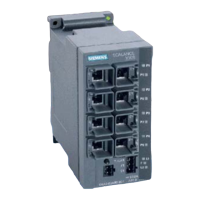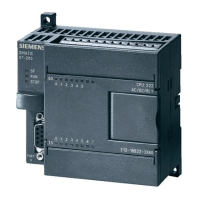Using the Text Display Wizard to Configure the S7-200 CPU for Your Text Display (TD) Device
4.5 Configuring the Alarms
Text Display (TD) User Manual
90 System Manual, 08/2008, A5E00765548-03
Another alarm cannot replace the one flashing until the operator acknowledges the flashing
alarm. This is also true even if a higher priority alarm is enabled in the S7-200 CPU. If the TD
device is configured for single line alarms and the CPU enables a higher priority alarm, the
flashing alarm shifts down to the next line of the display. The operator cannot press the UP
or the DOWN key to scroll through other enabled alarms until the current alarm is
acknowledged.
No Acknowledgement Required, Edits Allowed
In this combination of no acknowledgement required and edits allowed, the TD device
displays a alarm and then waits for the operator to edit a value in the alarm. All of the
variables within the alarm are updated at the update rate. Since the alarm does not require
acknowledgement, this type of alarm is removed from the TD device display if a higher
priority alarm is enabled in the S7-200 CPU.
Acknowledgement Required, Edits Allowed
In this combination of acknowledgement required and edits allowed, the TD device displays
the alarm, causes the entire alarm to flash (blink), and then waits until the operator
acknowledges the alarm and edits or accepts the values in the alarm. This type of alarm
requires that the operator edits or accepts the values displayed in the alarm. If the operator
aborts the edit by pressing the ESC key before editing all the values in the alarm, the alarm
flashes to indicate that edits are still required.
When the alarm is enabled in the S7-200 CPU, the TD device notes this and, if there is
space available on the display, reads the alarm from the CPU. The TD device then displays
the alarm and causes the entire alarm to flash to notify the operator that the alarm is present
and must be acknowledged.
Setting the Default Display Mode and Alarm Parameters
The TD device supports alarms that are displayed under program control. After you have
configured the TD device, you can configure the alarms. When you configure the alarms, you
also select either screens (default) or alarms as the default display mode for the TD device.
Click the Alarms icon to start creating alarms. As shown in the figure below, you select the
following information:
● Default display mode: Select either alarms or screens as the default display mode. This
selects which type of messages the TD device displays after powering up or after a
prolonged period of no key presses by the user.
● Size of the alarms: Select 1 line or 2 lines (TD 100C, TD200 and TD400C), or 4 lines
(TD400C only).
For Chinese characters, select either one row or two rows of text.

